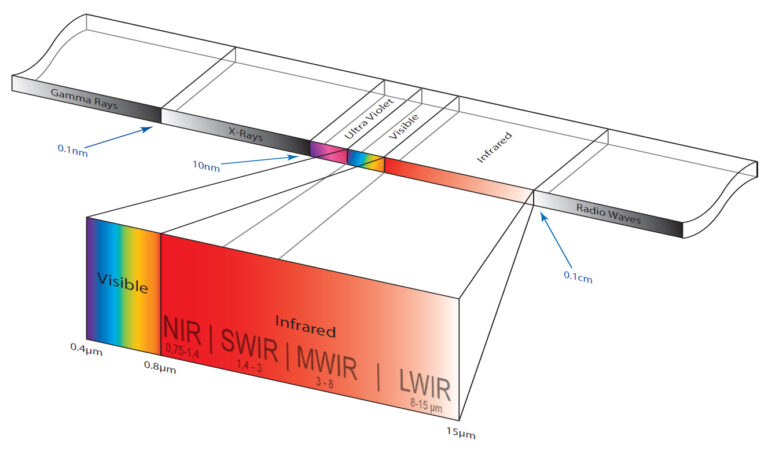Infrared (IR) technology has become increasingly prevalent in a variety of applications, from military and defense to environmental monitoring, medical diagnostics, and even consumer electronics. The infrared spectrum is typically divided into three main regions: Mid-Wave Infrared (MWIR Cameras), Short-Wave Infrared (SWIR Cameras), and Long-Wave Infrared (LWIR Cameras). Each of these regions has unique characteristics that make them suitable for different applications. Understanding these differences is crucial when deciding which type of IR technology to invest in.
Definitions Of Each Camera
Short-Wave Infrared (SWIR)
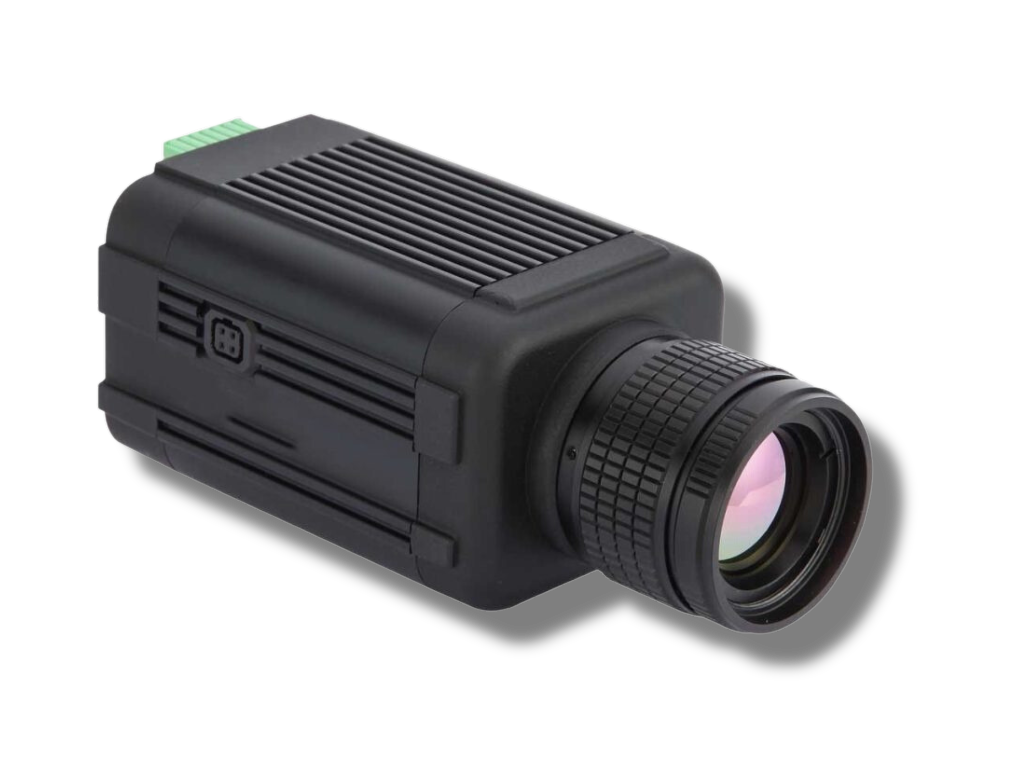
SWIR cameras operate in the wavelength range of 0.9 to 1.7 micrometers. At these shorter wavelengths, infrared radiation behaves similarly to visible light. It can be reflected and refracted, and it requires an external light source for imaging. This means that SWIR cameras can capture detailed, high-resolution images, but they may struggle in low-light conditions without an appropriate light source. However, the shorter wavelengths also allow SWIR radiation to penetrate certain materials, such as silicon, which can be useful in applications like semiconductor inspection.
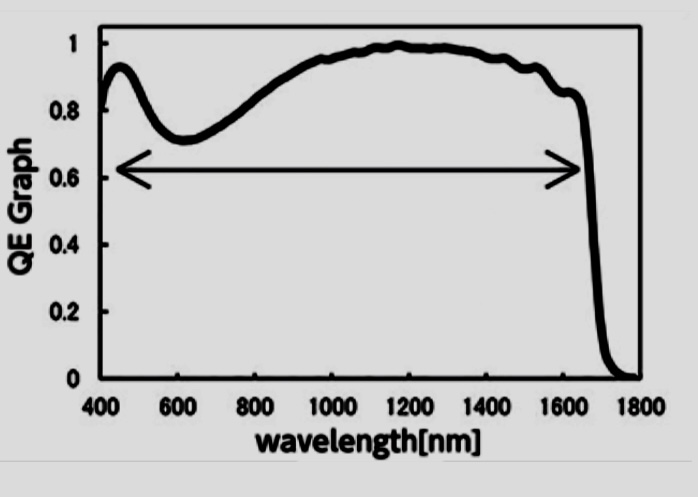
Mid-Wave Infrared (MWIR)
MWIR cameras operate in the wavelength range of 3 to 5 micrometers. This falls within the thermal infrared band, meaning that MWIR cameras can detect heat emitted by objects. They do not require an external light source and can operate effectively in complete darkness. The MWIR range is also known as the atmospheric window because the Earth’s atmosphere allows MWIR radiation to pass through with minimal absorption. This makes MWIR cameras ideal for long-distance thermal imaging applications.
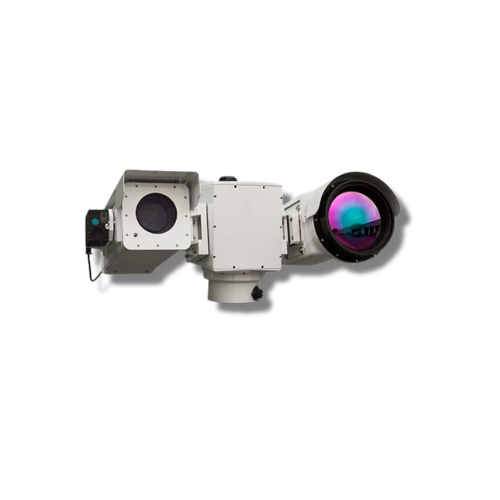
Long-Wave Infrared (LWIR)
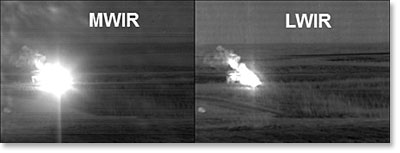
LWIR cameras operate in the wavelength range of 8 to 14 micrometers. Like MWIR cameras, LWIR cameras can detect heat emitted by objects and can operate in complete darkness. However, the longer wavelengths of LWIR radiation mean that it is less affected by atmospheric particles and can effectively penetrate smoke, fog, and dust. This makes LWIR cameras ideal for outdoor and long-range applications, as well as applications that require operation in challenging atmospheric conditions.
The General Guide For Purchasing Either SWIR, LWIR, or MWIR Cameras
- Indoor Surveillance with Good Lighting: If you’re monitoring an indoor area that has good lighting, go for a SWIR camera. It provides high-resolution images and can see through certain materials, making it ideal for detailed surveillance in well-lit conditions.
- Nighttime or Low-Light Surveillance: If you need to monitor an area in low-light conditions or complete darkness, choose a LWIR camera. It can detect heat signatures, allowing it to capture images even in the absence of light.
- Outdoor Surveillance in Challenging Weather Conditions: If you’re dealing with outdoor surveillance in areas prone to fog, dust, or smoke, a LWIR camera is your best bet. It can see through these atmospheric obscurants, ensuring clear imaging in challenging conditions.
- Detailed Surveillance in Variable Lighting: If you need detailed, high-resolution imaging in an area with variable lighting conditions, opt for a SWIR camera. It can provide detailed images in both well-lit and low-light conditions, as long as there is some level of ambient light.
- Thermal Imaging for Intruder Detection: If your primary need is to detect intruders based on their heat signatures, especially in complete darkness or over long distances, go for a MWIR camera. It’s excellent for thermal imaging and can detect subtle changes in temperature.
Camera Uses For Different Applications and Sectors
Short-Wave Infrared (SWIR) Cameras for Target Identification and Reconnaissance
A SWIR camera is the top choice for target identification and reconnaissance tasks in various lighting conditions. It provides high-resolution images and can see through certain obscurants like haze or fog, making it ideal for detailed surveillance.

Long-Wave Infrared LWIR Cameras for Nighttime Operations
For operations that take place in complete darkness, LWIR cameras are the go-to. Their ability to detect heat signatures allows them to capture images even in the absence of light, making them perfect for nighttime surveillance and target detection.
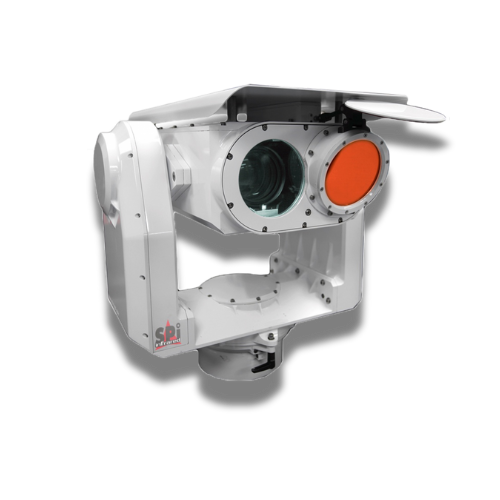
Long-Wave Infrared LWIR Cameras for Long-Range Surveillance
In scenarios involving long-range surveillance in areas prone to challenging weather conditions like fog, dust, or smoke, a LWIR camera is the best choice. Its ability to see through these atmospheric obscurants ensures clear imaging over long distances.
Mid-Wave Infrared (MWIR) Cameras for Thermal Imaging and Target Detection
If the main requirement is to detect targets based on their heat signatures, especially over long distances or in complete darkness, an MWIR camera is the ideal choice. It excels in thermal imaging and can detect subtle changes in temperature, making it ideal for spotting hidden or camouflaged targets.
The Geographical Influence On Camera Choice
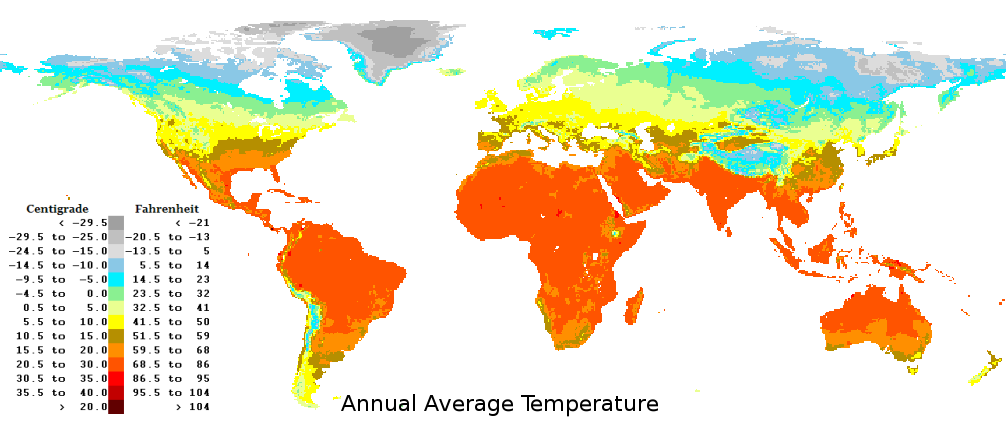
Global climatic zones, each with its unique atmospheric properties and background temperatures, significantly influence the performance of sensor technologies. Typically, Long-Wave Infrared (LWIR) systems are more effective in colder climates, while Mid-Wave Infrared (MWIR) systems tend to perform better in warmer climates.
Atmospheric Transmission Characteristics
The transmission of infrared radiation is contingent upon local atmospheric constituents, including aerosols, particles, and water vapor. MWIR systems exhibit superior resilience to humidity-induced degradation for most target ranges, rendering them advantageous for coastal surveillance, vessel traffic surveillance, or harbor protection.
However, both MWIR and LWIR cameras are susceptible to performance degradation in fog and rain. LWIR cameras exhibit superior performance in fog conditions and are more effective at imaging through smoke or aerosols, making them the preferred choice for firefighting and certain military applications.
Geographical and Climatic Considerations
The efficacy of infrared sensors is heavily influenced by geographical and climatic conditions. The thermal gradients in different global climatic zones, characterized by varying scene temperatures and atmospheric properties, can significantly impact sensor performance. LWIR cameras typically exhibit superior performance in colder climates, while MWIR systems are more effective in warmer climates.
Thermal Flux and Contrast
The thermal flux, or the thermal energy emitted by the targets and the environment background, is typically higher in the LWIR band at ambient temperatures. However, the thermal contrast, which is the ratio of the target flux to the background flux and is crucial for image formation, is generally greater in the MWIR band.
This is one of the reasons why MWIR systems are often preferred when budget constraints are less stringent. Furthermore, MWIR systems are more effective at detecting high-temperature targets such as airplanes or missiles, as their hot exhaust plumes are significantly more visible in the MWIR band.
Solar Influences
Solar effects can significantly impact the performance of infrared systems. LWIR cameras exhibit negligible solar effects, providing more consistent images between daytime and nighttime.
However, it’s crucial to ensure that LWIR cameras are resistant to direct solar exposure. Conversely, while most MWIR systems are resistant to direct solar exposure, their performance can be compromised by solar glints, such as sun reflections off water surfaces.
Economic Considerations
The cost-performance trade-off is a critical factor in the choice of infrared systems. Un-cooled LWIR cameras are economically accessible and suitable for most short and mid-range applications.
Conversely, cooled MWIR systems, while offering superior performance for long-range surveillance, are more expensive. Cooled LWIR cameras, typically used for long-range applications or specific military usage, are usually the most expensive. Un-cooled MWIR systems are not available for standard surveillance applications.
In conclusion, the optimal choice between MWIR and LWIR systems is contingent upon a multitude of factors, including atmospheric conditions, geographical and climatic considerations, thermal flux and contrast, solar influences, and economic constraints.
It’s advisable to leverage sophisticated software models that can simulate the performance of thermal cameras in specific surveillance scenarios, and consult us at SPI Corp for a demonstration to aid in the selection of the most appropriate thermal camera system.
